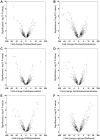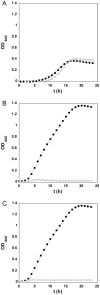Transcriptional analysis of prebiotic uptake and catabolism by Lactobacillus acidophilus NCFM
- PMID: 23028535
- PMCID: PMC3446993
- DOI: 10.1371/journal.pone.0044409
Transcriptional analysis of prebiotic uptake and catabolism by Lactobacillus acidophilus NCFM
Abstract
The human gastrointestinal tract can be positively modulated by dietary supplementation of probiotic bacteria in combination with prebiotic carbohydrates. Here differential transcriptomics and functional genomics were used to identify genes in Lactobacillus acidophilus NCFM involved in the uptake and catabolism of 11 potential prebiotic compounds consisting of α- and β-linked galactosides and glucosides. These oligosaccharides induced genes encoding phosphoenolpyruvate-dependent sugar phosphotransferase systems (PTS), galactoside pentose hexuronide (GPH) permease, and ATP-binding cassette (ABC) transporters. PTS systems were upregulated primarily by di- and tri-saccharides such as cellobiose, isomaltose, isomaltulose, panose and gentiobiose, while ABC transporters were upregulated by raffinose, Polydextrose, and stachyose. A single GPH transporter was induced by lactitol and galactooligosaccharides (GOS). The various transporters were associated with a number of glycoside hydrolases from families 1, 2, 4, 13, 32, 36, 42, and 65, involved in the catabolism of various α- and β-linked glucosides and galactosides. Further subfamily specialization was also observed for different PTS-associated GH1 6-phospho-β-glucosidases implicated in the catabolism of gentiobiose and cellobiose. These findings highlight the broad oligosaccharide metabolic repertoire of L. acidophilus NCFM and establish a platform for selection and screening of both probiotic bacteria and prebiotic compounds that may positively influence the gastrointestinal microbiota.
Conflict of interest statement
Figures




Similar articles
-
Transcriptional and functional analysis of galactooligosaccharide uptake by lacS in Lactobacillus acidophilus.Proc Natl Acad Sci U S A. 2011 Oct 25;108(43):17785-90. doi: 10.1073/pnas.1114152108. Epub 2011 Oct 17. Proc Natl Acad Sci U S A. 2011. PMID: 22006318 Free PMC article.
-
Transcriptional analysis of oligosaccharide utilization by Bifidobacterium lactis Bl-04.BMC Genomics. 2013 May 10;14:312. doi: 10.1186/1471-2164-14-312. BMC Genomics. 2013. PMID: 23663691 Free PMC article.
-
Enzymology and structure of the GH13_31 glucan 1,6-α-glucosidase that confers isomaltooligosaccharide utilization in the probiotic Lactobacillus acidophilus NCFM.J Bacteriol. 2012 Aug;194(16):4249-59. doi: 10.1128/JB.00622-12. Epub 2012 Jun 8. J Bacteriol. 2012. PMID: 22685275 Free PMC article.
-
Genetic mechanisms of prebiotic oligosaccharide metabolism in probiotic microbes.Annu Rev Food Sci Technol. 2015;6:137-56. doi: 10.1146/annurev-food-022814-015706. Epub 2014 Dec 19. Annu Rev Food Sci Technol. 2015. PMID: 25532597 Review.
-
Transporters of glucose and other carbohydrates in bacteria.Pflugers Arch. 2020 Sep;472(9):1129-1153. doi: 10.1007/s00424-020-02379-0. Epub 2020 May 6. Pflugers Arch. 2020. PMID: 32372286 Review.
Cited by
-
Comparative Transcriptional Analysis of Lactobacillus plantarum and Its ccpA-Knockout Mutant Under Galactooligosaccharides and Glucose Conditions.Front Microbiol. 2019 Jul 9;10:1584. doi: 10.3389/fmicb.2019.01584. eCollection 2019. Front Microbiol. 2019. PMID: 31338086 Free PMC article.
-
New Horizons in Probiotics: Unraveling the Potential of Edible Microbial Polysaccharides through In Vitro Digestion Models.Foods. 2024 Feb 26;13(5):713. doi: 10.3390/foods13050713. Foods. 2024. PMID: 38472826 Free PMC article. Review.
-
In Vitro Production of Galactooligosaccharides by a Novel β-Galactosidase of Lactobacillus bulgaricus.Int J Mol Sci. 2022 Nov 18;23(22):14308. doi: 10.3390/ijms232214308. Int J Mol Sci. 2022. PMID: 36430784 Free PMC article.
-
Safety of cellobiose as a novel food pursuant to regulation (EU) 2015/2283.EFSA J. 2022 Nov 9;20(11):e07596. doi: 10.2903/j.efsa.2022.7596. eCollection 2022 Nov. EFSA J. 2022. PMID: 36381122 Free PMC article.
-
Utilization of diverse oligosaccharides for growth by Bifidobacterium and Lactobacillus species and their in vitro co-cultivation characteristics.Int Microbiol. 2024 Jun;27(3):941-952. doi: 10.1007/s10123-023-00446-x. Epub 2023 Nov 9. Int Microbiol. 2024. PMID: 37946011 Free PMC article.
References
-
- Tang ML, Lahtinen SJ, Boyle RJ (2010) Probiotics and prebiotics: Clinical effects in allergic disease. Curr Opin Pediatr 22: 626–634. - PubMed
-
- Kootte RS, Vrieze A, Holleman F, Dallinga-Thie GM, Zoetendal EG, et al. (2012) The therapeutic potential of manipulating gut microbiota in obesity and type 2 diabetes mellitus. Diabetes Obes Metab 14: 112–120. - PubMed
-
- Scarpellini E, Campanale M, Leone D, Purchiaroni F, Vitale G, et al. (2010) Gut microbiota and obesity. Intern Emerg Med 5 Suppl 1: S53–6. - PubMed
-
- Hedin C, Whelan K, Lindsay JO (2007) Evidence for the use of probiotics and prebiotics in inflammatory bowel disease: A review of clinical trials. Proc Nutr Soc 66: 307–315. - PubMed
-
- Reid G, Sanders ME, Gaskins HR, Gibson GR, Mercenier A, et al. (2003) New scientific paradigms for probiotics and prebiotics. J Clin Gastroenterol 37: 105–118. - PubMed
Publication types
MeSH terms
Substances
Associated data
- Actions
LinkOut - more resources
Full Text Sources
Molecular Biology Databases

